The A-Z of Economics - introduction
Welcome to this Triple A Learning pack - the A-Z of Economics. The pack has a wide range of materials including a full economics glossary, a timeline of famous economists and information on different branches of economic theory. For more details on the contents, have a look at the next page.
A few words about Navigation
So that you can move to the next page in this pack more easily, each page has navigation tools in a bar at the top and the bottom. These tools are shown below.
![]() The right arrow at the top or bottom of the page will take you to the next page of content.
The right arrow at the top or bottom of the page will take you to the next page of content.
![]() The left arrow at the top or bottom of the page will take you to the previous page.
The left arrow at the top or bottom of the page will take you to the previous page.
![]() The home button will take you back to the table of contents for the pack.
The home button will take you back to the table of contents for the pack.
The pack is split into a series of sections and to access each section, the easiest way is to use the table of contents on the left-hand side of the page. To return to the full table of contents, please click on the 'home button' at any stage.
To start viewing the contents of the pack, please click on the right arrow at the top or bottom of the page.
Pack contents
This pack has a range of materials related to economics. The next section has a full economics glossary and this is then followed by:
- Fundamental economic concepts - this section looks at what might be termed a series of 'threshold concepts' for economics. Key, over-arching concepts that it is important to know for any economics course.
-
Key terms - there are key terms sections for all the main economics topics:
- Microeconomics
- Macroeconomics
- International economics
- Development economics
- Famous economists - who developed all the economic theories that we now study in economics? Find out some background on the best known economists from the 18th century right up to the present.
- Branches of economics - what are all the different branches of economics and what do they mean? Find out more about terms like 'neo-classical', 'laissez-faire' and 'Keynesian'.
- International organisations - what are all the key international organisations that monitor, regulate and organise world trade? Have a look at them in this section.
- Games and activities - why not test your knowledge of economic concepts and definitions with our flash cards, crosswords and other questions?
To start looking at the next page, click on the right arrow at the top or bottom of the page. To return to the table of contents at any time, just click the 'home' icon.
Economics glossary
It is important when studying economics to make sure you have a good understanding of all the economics jargon and, if there is one thing you can be sure of, economics has a lot of jargon! This pack will help you to understand all the jargon you need for studying Economics.
In this first section you will find a full economics glossary of terms and you can use this to keep referring to throughout your economics course. Whenever you come across a term, just come back to this section to check out the definition of the term.
For more detailed definitions of a selection of key terms for each topic in IB economics, have a look at the 'Key terms section'. Why not also test yourself with the games and activities section? This has a series of flash cards to help you revise the important terms and definitions.
To start looking at the next page, click on the right arrow at the top or bottom of the page. To return to the table of contents at any time, just click the 'home' icon.
Full glossary of economic concepts

Below is a full glossary of economics terms and concepts. To browse around, select the letter of the term you want to see and then click on the term itself.
If you would prefer to view this interaction in a new web window, then please follow the link below:
To start looking at the next page, click on the right arrow at the top or bottom of the page. To return to the table of contents at any time, just click the 'home' icon.
Fundamental economic concepts
In this section we look at a series of fundamental economics concepts. These are over-arching concepts that run right through the study of all aspects of economics. It is worth ensuring you are comfortable with all these before moving on to study further.
To start looking at the next page, click on the right arrow at the top or bottom of the page. To return to the table of contents at any time, just click the 'home' icon.
Economics as a social science
What is economics?
Economics is a social science as it is concerned with the study of human behaviour. It looks at how humans behave in markets, in firms, and in countries or economies. It also looks at how these economies interact. The 'humans' we are studying may be consumers, workers, decision-makers in firms, or members of the government.
The subject of economics has been defined in different ways. Here are some examples from famous economists:
- Adam Smith (1723-90) considered economics in terms of wealth and regarded his work as "an inquiry into the nature and causes of the wealth of nations".
- John Stuart Mill (1806-73) saw economics as the "practical science of the production and distribution of wealth".
- Thomas Carlyle (1795-1881) regarded economics as the "dismal science".
- Herbert Davenport (1861-1931) - economics is "the science that treats phenomenon from the standpoint of price".
- Alfred Marshall (1842-1924) - economics is "on the one side a study of wealth; on the more important, a part of the study of man".
- Lionnel Robbins (1898-1984) - "the science which studies human behaviour as a relation between ends and scarce means which have alternative uses".
Micro & macroeconomics
Firms, households and governments have differing objectives. In economics we are concerned with how the behaviour of these groups influences the others, and the success with which they achieve their objectives. This study, the study of the behaviour of component parts of an economy, we call microeconomics. We also look at aggregates of economic activity, and see how and why economies interact. This is the study of macroeconomics.
Thus, two more definitions to be remembered:
- Microeconomics is concerned with the individual component parts of the economy. It is the study of the behaviour of firms and consumers and the determination of market prices and quantities. It is the study of how scarce resources are allocated between alternative uses.
- Macroeconomics is the study of aggregates (totals) of economic activity. It looks at how economies work and behave as a whole, and is concerned with such factors as the overall price level and the rate of inflation, the level of employment and unemployment, the rate of growth of the total output of the economy, aggregate demand and supply and the balance of payments.
To start looking at the next page, click on the right arrow at the top or bottom of the page. To return to the table of contents at any time, just click the 'home' icon.
Economics and supermodels
Economics is a social science and looks at behaviour. A key part of what economists therefore try to do is to predict behaviour. To help them with this, they use techniques similar to those used in the natural sciences. Economists construct models to help them to explain and then predict behavior.
The models that economists use may be of the whole economy, or they may simply be of a part of the economy. For example, economists use the model of demand and supply to try to model the bahviour of an individual market. This is a microeconomic model and helps them to explain and preedict the way in which prices will move with changes in the levels of demand and supply. To try to explain the behaviour of the whole economy, they may construct a mathematical model of the whole economy - this is a macroeconomic model.
To construct a model it is necessary to draw up hypotheses about behaviour. These hypotheses can then be tested by observations and testing economic data. For example, we may draw up a hypothesis that when personal income rises, demand will also rise. This hypothesis can then be tested using empirical data from various economies and various different products to see if the data matches the hypothesis. This process is called induction; developing theories from observations of specific variables.
To start looking at the next page, click on the right arrow at the top or bottom of the page. To return to the table of contents at any time, just click the 'home' icon.
Ceteris-paribus
When examining issues and developing theories, economists often make an assumption called the 'ceteris paribus' assumption. Ceteris paribus is literally the Latin for 'other things being equal'. When we make a generalistation of some sort we often want to assume that nothing else changes that will affect the outcome. For example, if the demand for a good rises, then we would expect the price to rise as well, assuming that the cost of production has not fallen as well. In this situation we say that an increase in demand will cause an increase in price ceteris paribus (all other things being equal).
To start looking at the next page, click on the right arrow at the top or bottom of the page. To return to the table of contents at any time, just click the 'home' icon.
Positive and normative economics
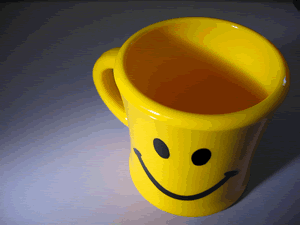 Economics is often split into two branches - positive and normative economics. Positive economics looks at economic issues that can be studied by looking at verifiable facts. Normative economics, on the other hand, looks at issues that involve value judgements or opinions. Thus normative economics means making a judgement based on an opinion which cannot be tested. Below we look in more detail at positive and normative statements.
Economics is often split into two branches - positive and normative economics. Positive economics looks at economic issues that can be studied by looking at verifiable facts. Normative economics, on the other hand, looks at issues that involve value judgements or opinions. Thus normative economics means making a judgement based on an opinion which cannot be tested. Below we look in more detail at positive and normative statements.
Positive and normative statements
Economists often make statements. Some of these are positive and are attempts at statements of fact or testable hypotheses. At other times, economists may venture to say what is right or wrong and in so doing will express opinions or views. Thus economics is concerned with two main types of statements.
Positive statements
These are statements of fact, or at least of a provable nature. Some examples:
- The retired population of Mexico has increased over the last 15 years.
- The Nigerian balance of payments deteriorated last month.
- Boys learn slower than girls.
- The moon is made of cheese.
- High mortgage interest rates encourage saving
- More African nations will qualify for the World Cup next time.
All of these are positive. They may not be true, but can be tested; i.e. they can be proved to be true or false.
Normative statements
Normative statements, or value judgements as they are sometimes called, are matters of opinion or statements of value. They cannot be tested or proven. Some examples:
- University students should be funded from a new, higher rate of income tax.
- Nobody should have to pay for hospital treatment.
- Mobile phones should be banned in all public places.
- Girls should be given higher university loans than boys.
- The present level of income tax is unfair.
- Acts of terror by the state cannot be justified
- Workers should receive a greater share of capitalists profits
They tend to contain words such as ought, should, fair, and inequitable.
To start looking at the next page, click on the right arrow at the top or bottom of the page. To return to the table of contents at any time, just click the 'home' icon.
Are people rational?
When we study economics, we often make the assumption that people will behave rationally. But what do we mean by rational behaviour? Generally speaking we expect people to make rational choices in their consumption decisions.
For example, if you want to buy a new car, how do you decide which car to buy? You may have a choice between an expensive sports-style car or a cheaper saloon car. The more expensive car will be more exciting to drive and give you more satisfaction, but the saloon car is cheaper. So, the sports car will have a higher opportunity cost; your income is not unlimited, so you will have to give up more other consumption to be able to afford it. Is the higher level of satisfaction enough to persuade you to spend more money?
In making this kind of choice, you are weighing up the costs and benefits of the decision and if the benefits of the sports car are greater than the costs, then you will purchase it. This is how we assume people behave. They make rtional rational decisions by weighing up the costs and benefits of any decision they make. This will apply not just to consumption, but also the choiccie of a job, the choice of leisure pursuits and so on.
We assume also that firms make rational decisions. When making decision like whether to introduce a new range of goods, or whether to produce more of an existing range, they will weigh up the costs and benefits of the decision and decide on that basis.
So all economic agents are generally assumed to be rational decision-makers.
To start looking at the next page, click on the right arrow at the top or bottom of the page. To return to the table of contents at any time, just click the 'home' icon.
Scarcity
We are all parts of an economy. We need and want many goods and services - we, individually and as groups, have unlimited wants. For example, if the students in your class were asked to write down all the things they want, the list would in all probability, be extremely long. If the experiment were repeated across the whole country, the list would be so enormous that it would be impossible to fulfil. This is because, compared with the unknown, potential desires of individuals for more and better goods and services, the means for satisfying these wants i.e. resources, are in strictly limited supply, or as economists would say, scarce. So economics is:
THE STUDY OF HOW SCARCE RESOURCES ARE OR SHOULD BE USED
Economics looks at these scarce resources and aims to see how they can be used (economists say allocated) in the most efficient way. So we can say that the fundamental problem that we study in economics is how best to allocate scarce resources amongst all their many alternative uses in order to satisfy human wants.
So, we know that the fundamental economic problem is that of scarcity. There are simply not enough resources to provide sufficient goods and services to satisfy the world's unlimited wants. These resources are known as the FACTORS OF PRODUCTION and economists split them into four groups. What do you think the main groupings are? Make some suggestions, and then click away. Think carefully what firms need in order to produce goods and services. We often call these factors of production the inputs for production.
Never forget, however, that one of the scarcest and most valuable resources available to us is a clean, sustainable environment.

Question
In the world economy of today, which is increasingly dominated by large multinational corporations, the entrepreneur of conventional economic theory is becoming increasingly difficult to identify. Why do you think this is?
Answer
Payment to factors of production
These factors of production that we have identified each earn a different form of income. When we offer our labour services to an employer, we don not do it out of some misplaced loyalty or altruism; we do it to earn money. So from labour we earn an income of wages. What do you think the other factors of production earn? Have a think and then click on INCOMES.
To start looking at the next page, click on the right arrow at the top or bottom of the page. To return to the table of contents at any time, just click the 'home' icon.
What? How? For whom?
We have already identified the fundamental economic problem as scarcity. There are not enough resources to cater for all the unlimited wants of people. Because of this scarcity, economists and governments try to answer three fundamental questions:
- WHAT TO PRODUCE?
- FOR WHOM TO PRODUCE?
- HOW TO PRODUCE?
What to produce?
This decision is a matter for both government and the private sector. The government has to decide what goods and services to provide and how much of each to provide. As we have seen, more of one thing generally means less of another (opportunity cost), so some difficult decisions arise here.
The private sector also has to decide what to produce, but this will tend to be decided by the market. Firms will examine demand and try to produce goods where there is the greatest level of demand. This question is then answered by the market forces of demand and supply.
For whom to produce?
This question is looking at the distribution of the goods and services we produce. Factors of production earn incomes. These incomes can be used to purchase goods and services. So the higher the level of income, the more goods and services can be demanded. In the market sector of the economy, this question is therefore decided by relative rewards to factors of production. Different criteria will be applied in the case of government provided services such as free state education.
How to produce?
Firms will decide this on the basis of cost. Their aim, as we have seen, is to make a profit - in fact the maximum profit possible. To help them do this, they need to produce as efficiently as possible. The more efficiently they produce, the lower the cost of production. So how much they use of each factor of production will depend on how much that factor costs and how productive it is. If labour is cheap, but nevertheless nearly as productive as more expensive machinery, then the firm may choose labour intensive production. If, however, machines are more productive per dollar spent, then they may choose capital intensive production.
Economies approach these questions in different ways. Some may choose to have a large government sector (perhaps even total state control) whereas other may choose to leave things almost totally to the private sector and markets. This means that economists consider three different types of economy: mixed economies, free market economies and centrally planned economies.
To start looking at the next page, click on the right arrow at the top or bottom of the page. To return to the table of contents at any time, just click the 'home' icon.
Choice and opportunity cost
Choice
Economics, as we are starting to see, is about the making of choices and the taking of decisions. We all have limited resources and have to decide how we are to use them. Good decisions will only be taken if the correct information is available. Even so, the actual decision will be based on non-economic as well as economic considerations. You 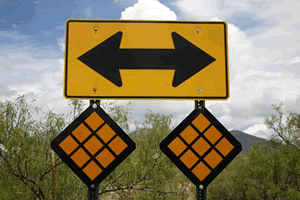 are faced with choices and decisions every day, economic choices and decisions which impact on other economic agents. Some examples:
are faced with choices and decisions every day, economic choices and decisions which impact on other economic agents. Some examples:
- Will I spend the majority of my spare time studying economics and my other HL and SL subjects or will I pursue my leisure interests? (Less IB studying, more money spent on leisure, less exam success, greater pressure on your teachers).
- Will I go to college on foot, or will I get Mum to take me in the car? (More pollution from the car, more demand for oil, Mum cannot do anything else whilst she wastes her time driving to and from College).
- Will I buy a new textbook, or another CD? (Cannot have both. How do I decide? Some part of industry gains, the other suffers).
Choices, decisions, consequences, both for the decision taker and many other parts of an economy.
Opportunity cost
When you buy something you exchange cash for a product or service. For most people, cash is relatively scarce. So when it is spent on something it cannot be used to buy something else. This introduces the concept of opportunity cost.
Opportunity cost
The opportunity cost of an activity is the sacrifice made to do it. It is the real cost of the next best alternative foregone. The more a nation produces of one thing, the less of something else it can produce. The sacrifice of the alternative is the opportunity cost.
A few examples:
- The government choose to spend more on health care. This may mean sacrifices elsewhere and may mean less spent on affordable housing. The reduction in housing is the opportunity cost.
- The opportunity cost of working overtime (supplying more labour) is the leisure time that you have sacrificed.
- You own a lawnmower that you rarely use. It has a second hand value of $50. The opportunity cost of keeping the mower is $50.
- You are given $400 as an 18th birthday present. You decide to spend it on a holiday rather than put it into a long - term saving account. The opportunity cost of the holiday is the savings that have been given up.
- You buy a CD instead of purchasing lunches for a week. The opportunity cost of the CD is the lunches given up.
The fact that there is an opportunity cost to every transaction means that we all face trade-offs in the decisions we make. As a society, we cannot have everything we want and so to have more of one thing, we may have to have less of another. This notion of trade-offs is one that will recur throughout your economics course. It will also arise when we look at the management of the national economy as governments face trade-offs as well as individuals. They may want low unemployment and low inflation, but less of one may mean more of the other.
Remember, however, that opportunity cost is not a financial cost - it is a resource cost, i.e. what's given up in real, as opposed to money terms.
To start looking at the next page, click on the right arrow at the top or bottom of the page. To return to the table of contents at any time, just click the 'home' icon.
Production possibility curves
Production possibility curve
A production possibility curve (sometimes known as a production possibility frontier, boundary or line) is a curve which indicates the maximum combination of any two goods which an economy could produce if all its resources were
(a) fully employed and
(b) organised as efficiently as possible.
How is the curve constructed?
Consider the choice facing many economies today, i.e. between producing say armaments or welfare services (economists sometimes refer to this as the 'guns versus butter' problem). This is a problem in the allocation of society's scarce resources. (Clearly more of one means less of another, so this is also a problem of opportunity cost). We can represent this choice on a diagram as in Figure 1 below.
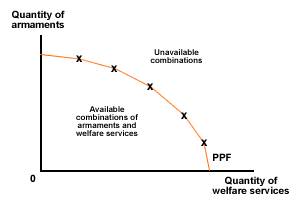
Figure 1 Constructing a production possibility curve
- On one axis we measure the quantity of armaments, on the other welfare services
- Next plot all those combinations of armaments and welfare services, if resources are fully employed (the X's in figure 1)
- Join up these points and the resulting line is called the production possibility curve
The PPC and opportunity cost
The downward slope of the line or curve indicates that there is an opportunity cost in producing more of one type of commodity.
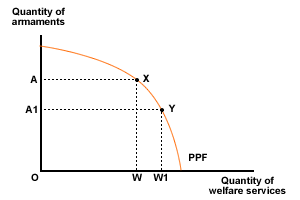
Figure 2 Opportunity cost
We can see this opportunity cost in figure 2. If we move from point X to point Y we are reallocating resources out of armaments production and into welfare services production. Armaments production falls from OA to OA1 and welfare services production increases from OW to OW1. The opportunity cost of WW1 additional welfare services is AA1 armaments foregone.
The economy inside the PPC
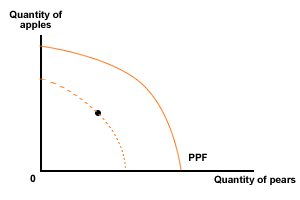
Figure 3 Unemployment=Inefficient resource use
The economy may be producing at some point inside the curve (producing less of both goods). There are two main reasons for this:
- Unemployment of resources
- Inefficient use of resources
So, in figure 3 the solid curve is the PPC with full employment, while the dotted line is the PPC with unemployment.
Actual growth and potential growth
Actual growth
If an economy is operating inside its PPC and produces more as a result of using previously unemployed resources, or using resources more efficiently, this is referred to as actual growth. This is illustrated in figure 4 below by a movement from a point within the PPC to a point towards or on the PPC.
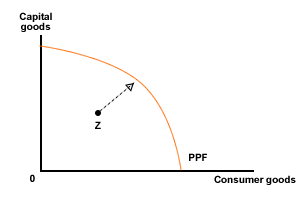
Figure 4 Actual growth
The movement from point Z towards the PPC represents an increase in actual growth.
Potential growth
The productive potential of an economy may be increased by an increase in the quality and/or quantity of resources and, when this occurs, this is known as potential growth.
This is illustrated in figure 5 below by an outward shift of the PPC.
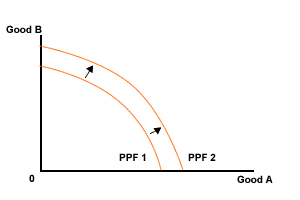
Figure 5 Potential growth
This denotes an increase in the productive capacity or potential of the economy as more of both goods can now be produced.
Difference between growth and development
As noted in Section 1.3, economic development is a broader concept than economic growth. While economic growth is measured by the increase in a country's real level of output over time, economic development might additionally involve changes in the composition of output, a more equal distribution of income, greater access to health care etc.
This difference can be illustrated using a PPC. The two previous diagrams (Figures 4 and 5) indicate an increase in economic growth through an increase in potential and actual output. Figure 6 below indicates economic development.
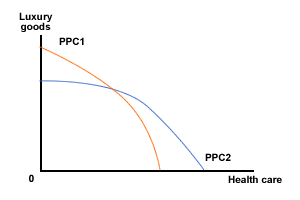
Figure 6 Economic development
The switch from PPC1 to 2 shows more of society's resources being used for the production of health care and less for the production of luxury goods. This is one indicator of economic development, providing sufficient people have access to the greater health care.
Figure 7 shows economic growth and development occurring together.
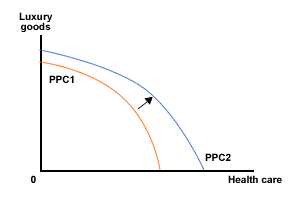
Figure 7 Economic growth and development
The PPC has shifted outwards denoting economic growth, but proportionately more of the economy's resources are now devoted to the output of health care rather than luxury goods as compared with the original position (PPC1).
The productive potential of the economy has increased (economic growth) and there has been a qualitative improvement in the composition of the nation's output (economic development).
PlotIT - Build a production possibility curve
The table below shows the production possibilities for country X. Calculate the figures in the third row of the table by calculating the opportunity cost of producing each extra unit of clothing. Jot these down on a piece of paper. You can check your answer if you want to.
| Units of clothing | 0 | 1 | 2 | 3 | 4 | 5 | 6 |
|---|---|---|---|---|---|---|---|
| Units of food | 24 | 23 | 21 | 18 | 14 | 8 | 0 |
| Opportunity cost of producing one extra unit of clothing | - |
Now use the first two rows of the table to plot the production possibility curve on the following diagram. Do this by clicking on each point in turn. Thus for the first point, click the mouse on the point that corresponds to 0 units of clothing and 24 units of food. Then click on the point corresponding to 1 unit of clothing and 23 units of food, and so on.
You may like to check your answer to see how your diagram compares.
Now assume that improvements in technology increase food production by 25 per cent. Fill in the new possibilities for food production and calculate the new opportunity costs of producing extra units of clothing. Jot these down on a piece of paper. You can check your answer if you want to.
| Units of clothing | 0 | 1 | 2 | 3 | 4 | 5 | 6 |
|---|---|---|---|---|---|---|---|
| Units of food | 24 | 23 | 21 | 18 | 14 | 8 | 0 |
| Opportunity cost of producing one extra unit of clothing | - | 1 | 2 | 3 | 4 | 6 | 8 |
| Units of food after the change in technology | |||||||
| New opportunity cost of producing extra units of clothing |
On the diagram above, plot the new production possibility curve by clicking on each of the points corresponding to rows 1 and 4 of the above table in turn as before. You may like to check your answer to see how your diagram compares.
To start looking at the next page, click on the right arrow at the top or bottom of the page. To return to the table of contents at any time, just click the 'home' icon.
Intervention
Governments need to decide how much to intervene in an economy to influence the allocation of resources. The extent of this intervention depends essentially on the way in which they view the efficiency of markets in allocating resources. To help us understand the reasons for, and nature of, this intervention, we identify three different types of economy.
Types of economy
If we think about the economies of USA, Great Britain, France, Russia, China, North Korea and Cuba, are they all the same?
There are two theoretical types of economy, free market and command. Neither of these exists completely in the real world, and all economies are a mixture of both. However, the proportions of free market and command within mixed economies vary considerably.
Free market economies
In a true free market economy there is no government intervention at all. All decisions are left to the market mechanism. Decisions are made by individuals and firms on the basis of supply and demand. Firms use the factors of production to produce what is wanted and the goods and services which give them the most profit. Customers with the most money buy them. It is the 'survival of the fittest' as there would be no government services available for the poor. If you cannot pay, you do not get, and that includes medical services!
Which economy gets nearest to being a pure free market economy? USA and Canada are closer than China.
Centrally planned economies
In centrally planned economies (sometimes known as command economies) the government makes all decisions. There is a central planning organisation, which attempts to co-ordinate all activities. There is little consumer choice. Demand, however, still exists but is not automatically responded to. It should, in theory, put the environment first, regardless of cost.
No fully centrally planned economy has existed. The old USSR and China got close, but there was always a free market element left. Most of the economies which were previously centrally planned, e.g. the USSR, the East European economies and China, are now market economies.
Mixed economies
Mixed economies consist of a private sector, in which resources are owned and controlled by private individuals, and a public sector in which resources are owned and controlled by the state. In practice, both the market mechanism and the state have a role to play, and so we describe most economies as mixed. In an ideal world both sectors would produce what they are best at. Some things cannot be provided by the market mechanism alone or, in sufficient quantities through the market, and here government provision may be necessary (see Section 2.4).
So, all economies are mixed, but the mix between public and private control varies.
We therefore have to develop theories that allow for three types of economy.
- Market economies
- Mixed economies
- Centrally planned economies
This can be illustrated on a diagram or spectrum where the type of economy is placed on a scale of government control.

Figure 1 Degree of government intervention
This spectrum shows us where different economies lie in terms of the mix between government intervention and the free market. The further to the left on the spectrum, the more the economy relies on the free market to allocate resources. The further to the right on the spectrum, the larger the role the government plays in the allocation of resources and the closer the economy is to a centrally planned economy.
However, this is a very single dimensional view of a mixed economy and it is important to be aware that governments also differ in the type of intervention as well as the quantity of intervention. For example, governments tend to intervene to ensure that certain goods and services of value to society are produced (e.g. health care). Some governments may intervene by providing these directly, while others may rely on the private sector to provide them, but with rules and regulations on how the good or service is provided. Thus governments may have similar positions on the spectrum, but the nature of the intervention may be very different.
To start looking at the next page, click on the right arrow at the top or bottom of the page. To return to the table of contents at any time, just click the 'home' icon.
Sustainability
Sustainability
The ability of the environment to survive its use for economic activity.
For economic growth to be sustainable, it must have a neutral effect on resources. Any resources used must be renewable and there must be no lasting impact on the environment. Why is sustainable development important then? Well, it is important that development is sustainable to ensure that it can endure in the long-term and is not built on the exploitation of natural resources that may run out in the future.
To start looking at the next page, click on the right arrow at the top or bottom of the page. To return to the table of contents at any time, just click the 'home' icon.
Economic efficiency and equity
Economics is the study of how scarce resources are allocated; that is how a society answers the questions what, how and for whom? The objectives of equity and efficiency can help us judge how well we are managing to answer these questions.
Efficiency
Economic efficiency looks at whether we could, as a society, produce more or make some people better off without making others worse off . If this is the case, then we are not economically efficient. This concept can be illustrated by the production possibility frontier. In the diagram below, the point inside the ppf is economically inefficient. We could produce more apples and more pears, therefore making some people better off and nobody worse off. All points on the ppf itself will therefore be economically efficient.
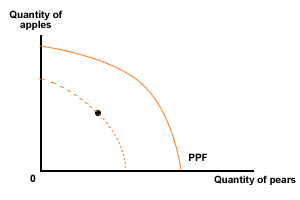
Figure 1 Inefficient resource use
Economic efficiency requires the following conditions to be met:
- Efficiency in production - productive efficiency requires firms to be producing goods at the minimum possible level of cost.
- Efficiency in consumption - this means consumers spending their money as efficiently as possible to maximise the utility (satisfaction) they get from their limited incomes
- Efficiency in specialisation and exchange
The last two of these are collectively known as allocative efficiency. Allocative efficiency occurs when consumers are gaining the maximum possible satisfaction at their current level of income.
Equity
Equity is another objective that may be pursued by governments and economic policy makers. Equity is a situation when income is distributed in a way that we could consider to be fair or just. This is NOT the same as an equal distribution of income. Equity is possible when income is unevenly distributed, so long as this distribution is considered fair and just. The problem is that people and governments will differ significantly on what they consider to be fair. A more laissez-faire government is likely to consider a more unequal distribution of income to be fair, while a more socialist government will want a more equal distribution of income as their objective.
Economic efficiency does not in itself lead to greater equity, indeed there may be conflicts between these objectives.
To start looking at the next page, click on the right arrow at the top or bottom of the page. To return to the table of contents at any time, just click the 'home' icon.
Economic growth and development
Economic growth
This occurs where there is an increase in the productive potential of the economy and is best measured by the increase in a country's real level of output over a period of time i.e. the increase in real Gross Domestic Product (real means adjusted for inflation).
Economic development
Economic development, on the other hand is a process where there is improvement in the lives of all people in the country. This involves not only living standards, such as greater availability of goods and services (and also the ability to purchase them) but also the promotion of attributes such as self-esteem, dignity and respect, and the enlarging of people's freedom to choose and to take control of their own lives. While a country may grow richer therefore, through the growth of its real output, it does not necessarily mean that it will experience development.
For a long period of time, economic development was seen to be a factor of economic growth. It was believed that economic development occurred when there was a high level of industrialisation and economic growth; social factors, such as poverty and unemployment were of lesser importance. It was also believed that the material benefits of growth would trickle down from the better off to the rest of the population, causing development. However, many developing nations have managed to achieve high rates of economic growth, yet have failed to experience any positive change in standards of living for the majority of their people. It was realised therefore that the definition of economic development had to be changed. As Dudley Seers says: "if one or two of the central problems (poverty, unemployment or equality) have been growing worse, especially if all three have, it would be strange to call the result 'development' even if per capita income doubled"(from D.Seers, 'The meaning of economic development').
According to Professor Michael Todaro, development should involve the following objectives:
- "To increase the availability and widen the distribution of basic life-sustaining goods such as food, shelter, health and protection.
- To raise levels of living including, in addition to higher incomes, the provision of more jobs, better education, and greater attention to cultural and humanistic values, all of which will serve not only to enhance material well-being but also to generate greater individual and national self-esteem.
- To expand the range of economic and social choices available to individuals and nations by freeing them from servitude and dependence not only in relation to other people and nation-states but also to the forces of ignorance and human misery."
(from M.P.Todaro 'Economic development')
There are several measures that are used to measure economic development such as GNP/GDP per capita, population growth and structure, health, education, technology, employment, rural/urban migration, rights of women and distribution of poverty and income. Statistically GDP per capita is generally acknowledged as the best single indicator but composite indicators of development are also used. One such index is the Human Development Index (HDI) which includes GDP per capita, life expectancy and literacy rates.
To start looking at the next page, click on the right arrow at the top or bottom of the page. To return to the table of contents at any time, just click the 'home' icon.
Key terms

In this section we look in more detail at key terms for each different area of economics. On the following pages, we look at key terms for:
- Microeconomics
- Macroeconomics
- International economics
- Development economics
To start looking at the next page, click on the right arrow at the top or bottom of the page. To return to the table of contents at any time, just click the 'home' icon.
Microeconomics

We have split the key terms for microeconomics into a number of different pages. Follow the link below for the section you want to look at:
- Competitive markets; demand and supply
- Elasticity
- Government intervention
- Market failure
- Theory of the firm and market structures
The key terms interaction should open in a new window when you follow the links above.
To start looking at the next page, click on the right arrow at the top or bottom of the page. To return to the table of contents at any time, just click the 'home' icon.
Macroeconomics

We have split the key terms for macroeconomics into a number of different pages. Follow the link below for the section you want to look at:
- The level of economic activity
- Aggregate demand and supply
- Macroeconomic objectives
- Macroeconomic policy
The key terms interaction should open in a new window when you follow the links above.
To start looking at the next page, click on the right arrow at the top or bottom of the page. To return to the table of contents at any time, just click the 'home' icon.
International economics

We have split the key terms for international economics into a number of different pages. Follow the link below for the section you want to look at:
The key terms interaction should open in a new window when you follow the links above.
To start looking at the next page, click on the right arrow at the top or bottom of the page. To return to the table of contents at any time, just click the 'home' icon.
Development economics

Follow the link below to see the key terms for development economics:
The key terms interaction should open in a new window when you follow the link above.
To start looking at the next page, click on the right arrow at the top or bottom of the page. To return to the table of contents at any time, just click the 'home' icon.
Famous economists
In this section we take a look at famous economists through the ages. These economists are the ones who have developed economic theories and policies throughout the centuries and their work will still be evident in the economics you are studying, so it is worth knowing a little bit about them and the work they did.
If you would prefer to view this interaction in a new web window, then please follow the link below:
To start looking at the next page, click on the right arrow at the top or bottom of the page. To return to the table of contents at any time, just click the 'home' icon.
Branches of economics
In this section we take a look at various different branches of economics. These include areas like classical and Keynesian economics.
If you would prefer to view this interaction in a new web window, then please follow the link below:
To start looking at the next page, click on the right arrow at the top or bottom of the page. To return to the table of contents at any time, just click the 'home' icon.
International Organisations
In this section we take a look at the various different international organisations that regulate, monitor and support world trade. We also look at organisations that support development in less developed countries.
If you would prefer to view this interaction in a new web window, then please follow the link below:
To start looking at the next page, click on the right arrow at the top or bottom of the page. To return to the table of contents at any time, just click the 'home' icon.
Games and activities
In this section are some games and activities to help you get to grip with terms and definitions in economics. You could try some crosswords, or perhaps a game of tic-tac-toe or, if you are revising, you might like to try going through the flashcards for each section.
To start looking at the next page, click on the right arrow at the top or bottom of the page. To return to the table of contents at any time, just click the 'home' icon.
Tic Tac Toe
Follow the appropriate link below for the Tic Tac Toe game you want to try:
- Tic Tac Toe - competitive markets
- Tic Tac Toe - elasticity
- Tic Tac Toe - government intervention
- Tic Tac Toe - market failure
- Tic Tac Toe - theory of the firm and market structures
- Tic Tac Toe - macroeconomics
- Tic Tac Toe - international economics
The tic tac toe game should open in a new window when you follow the links above.
To start looking at the next page, click on the right arrow at the top or bottom of the page. To return to the table of contents at any time, just click the 'home' icon.
Crosswords
Why not try some economics crosswords to see how well you know your terms and definitions? Follow the links below to access interactive versions of the crosswords.
- Microeconomics crossword
- Macroeconomics crossword
- International economics crossword
- Development economics crossword
These links should open in a new web window and you should be able to complete the crosswords on-screen.
If you prefer, you could alternatively download pdf versions of the crosswords and print them out to complete them. Follow the links below to download the equivalent pdf files.
- Microeconomics crossword
- Macroeconomics crossword
- International economics crossword
- Development economics crossword
To start looking at the next page, click on the right arrow at the top or bottom of the page. To return to the table of contents at any time, just click the 'home' icon.
Wordsearch
Why not try some economics wordsearches to see how well you know your terms and definitions? Follow the links below to access interactive versions of the wordsearch puzzles.
- Microeconomics wordsearch
- Macroeconomics wordsearch
- International economics wordsearch
- Development economics wordsearch
These links should open in a new web window and you should be able to complete the wordsearches on-screen by selecting the appropriate words on-screen.
If you prefer, you could alternatively download pdf versions of the wordsearches and print them out to complete them. Follow the links below to download the equivalent pdf files.
- Microeconomics wordsearch
- Macroeconomics wordsearch
- International economics wordsearch
- Development economics wordsearch
To start looking at the next page, click on the right arrow at the top or bottom of the page. To return to the table of contents at any time, just click the 'home' icon.
Flash cards - microeconomics
We have split the flash cards for microeconomics into a number of different pages. Follow the link below for the section you want to look at:
- Competitive markets; demand and supply
- Elasticity
- Government intervention
- Market failure
- Theory of the firm and market structures
The flash cards should open in a new window when you follow the links above.
To start looking at the next page, click on the right arrow at the top or bottom of the page. To return to the table of contents at any time, just click the 'home' icon.
Flash cards - macroeconomics
We have split the flash cards for macroeconomics into a number of different pages. Follow the link below for the section you want to look at:
- The level of economic activity
- Aggregate demand and supply
- Macroeconomic objectives
- Macroeconomic policy
The flash cards should open in a new window when you follow the links above.
To start looking at the next page, click on the right arrow at the top or bottom of the page. To return to the table of contents at any time, just click the 'home' icon.
Flash cards - International economics
We have split the flash cards for international economics into a number of different pages. Follow the link below for the section you want to look at:
The flash cards should open in a new window when you follow the links above.
To start looking at the next page, click on the right arrow at the top or bottom of the page. To return to the table of contents at any time, just click the 'home' icon.
Flash cards - development economics
Follow the link below to see the flash cards for development economics:
The flash cards should open in a new window when you follow the link above.
To start looking at the next page, click on the right arrow at the top or bottom of the page. To return to the table of contents at any time, just click the 'home' icon.
Quiz
Why not have a go at the quiz below to see how well you know your economics terms and definitions?
The quizzes should open in a new window when you follow the links above.
To start looking at the next page, click on the right arrow at the top or bottom of the page. To return to the table of contents at any time, just click the 'home' icon.
IB Assessment
In this section are details of IB assessment. The next two pages look at:
- Assessment structure - the exam papers and the various forms of assessment that you will have to take
- Assessment terms and definitions - command terms and other definitions to help you prepare better for IB exams
Assessment structure
If you would prefer to view this interaction in a new web window, then please follow the link below:
To start looking at the next page, click on the right arrow at the top or bottom of the page. To return to the table of contents at any time, just click the 'home' icon.
Assessment terms and definitions
If you would prefer to view this interaction in a new web window, then please follow the link below:
